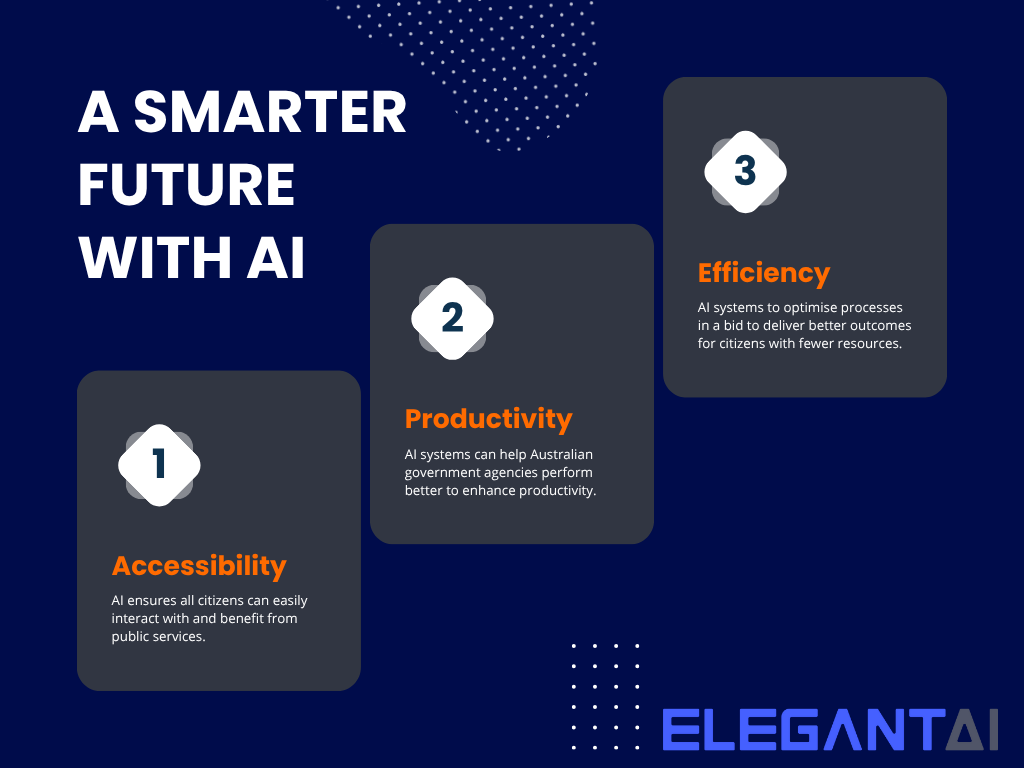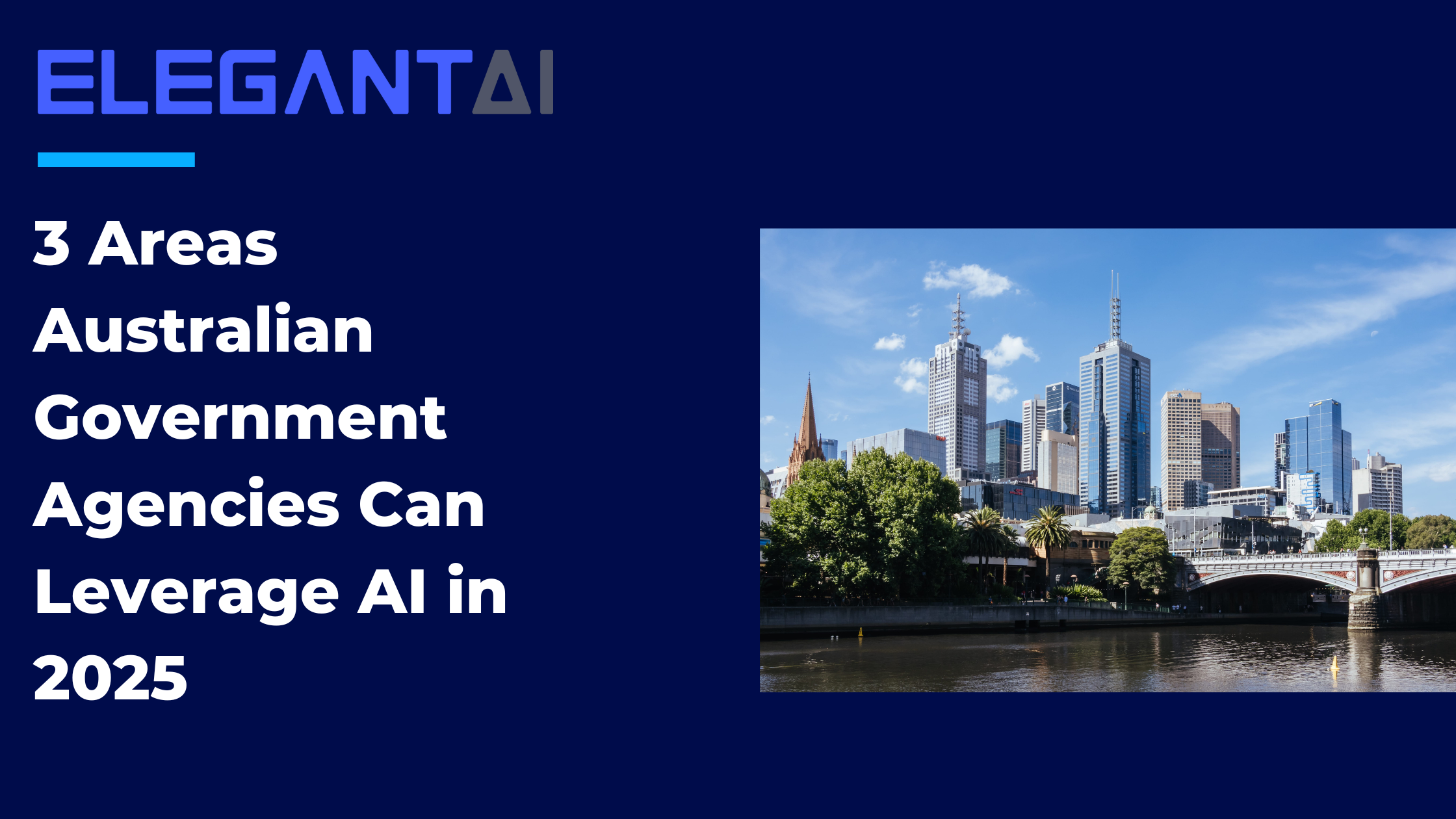Artificial Intelligence (AI) tools and systems have the potential to reshape how government agencies operate in delivering services to the public.
In this blog post we will explore How Australian Government Agencies Can Leverage AI in terms of amplifying Accessibility, Productivity, and Efficiency.
Why AI Matters to the Public Sector
The public sector handles vast amounts of information, from healthcare records and environmental data to transportation logistics and immigration systems. Yet many departments still rely on legacy systems and manual processes. AI in public services can change this dynamic by automating repetitive tasks, analysing large datasets in real-time, and delivering insights that enhance service quality and responsiveness.
54% of Australians believe AI will free up workers time so they can focus on the more rewarding aspects of work

How can Australia’s Public Sector truly harness AI’s Power?
1. Enhancing Accessibility: Reaching Every Australian
AI can play a transformative role in ensuring all citizens can easily interact with and benefit from public services ensuring that accessibility for government agencies is a paramount consideration.
- Intelligent Chatbots and Virtual Assistants: Imagine a Virtual Assistant for Services Australia that can seamlessly answer complex queries about benefits, provide personalised guidance, or help complete applications 24/7. This reduces wait times and contributes to uplifting the citizen support experience.
The Australian Taxation Office’s virtual assistant, Alex, is already demonstrating this capability, handling millions of conversations and easing the burden on call centres and support teams.
- Personalised Information Delivery: AI tools can simplify complex documents, provide information in multiple languages, or adapt content for individuals with disabilities, so public sector content is tailored for each audience for better understanding. To do this an ongoing analysis of citizen preferences and historical interactions is required.
- Examples Include:
- Recommending government programs based on the citizen
- Send automated reminders for license renewals and other government functions
- Improved Digital Inclusion: AI-powered text-to-speech technology can play a role in making government websites and applications more user-friendly for people with diverse needs including those with special needs. Natural Language Processing (NLP) helps bridge communication gaps and remove barriers for non-English speakers.
Examples include:
- Real-time transcription for hearing-impaired individuals
- Voice-controlled interfaces for those with limited mobility
- AI can convert public documents into accessible formats ensuring equal access for all citizens.
2. Boosting Productivity: Doing More with Less
AI systems can help Australian government agencies perform better often amidst a context of limited resources in order to enhance productivity levels.
- Automating Repetitive Tasks: From data entry, record keeping and report generation to initial document review and scheduling, AI-powered Robotic Process Automation (RPA) can take over mundane, rule-based tasks. This will flag inconsistencies in submitted documents and free up the time of human team members to focus on high-value activities that require human intervention.
Examples include:
- When it comes to filing of taxes, social benefits, or permit applications, AI can extract and interpret data from handwritten forms, scanned documents, and PDFs, reducing manual data entry errors and speeding up approvals.
- Streamlined Workflows: Public sector workflows are often characterised by flaws that impede performance. AI technology can analyse existing workflows, identify bottlenecks, and suggest process optimisations. This can involve automating approvals, intelligently routing requests to the right department, or predicting peak demand periods to allocate government resources more effectively.
Examples include:
- AI systems can prioritise and route cases more effectively in areas such as social services or healthcare ensuring timely responses.
- Enhanced Data Analysis and Insights: Australian government agencies handle vast amounts of data. From forecasting public health needs to optimising traffic flow in Smart Cities, AI models can rapidly process and analyse data to identify trends, predict outcomes, and provide actionable insights for operational improvements thereby helping public servants make faster, evidence-based decisions.
We help federal or local, council, organisations, institutions, departments, ministries and agencies achieve their goals with comprehensive AI solutions. Book a no-obligation AI Consultation to learn more about how AI boosts the provision of public services for the better.
3. Driving Efficiency: Smarter Operations for Better Outcomes
Government agencies looking at making smarter decisions and allocating resources in a more strategic manner can employ AI systems to optimise processes in a bid to deliver better outcomes for citizens with fewer resources
- Predictive Analytics for Resource Allocation: AI tools can predict future demands for services by analysing historical data and current trends. This can help government agencies to allocate resources where they’re most needed, improving service times and preventing backlogs.
Examples include:
- Predicting traffic congestion and optimising public transport routes
- Anticipating healthcare needs based on population data
- Fraud Detection and Risk Mitigation: In order to strengthen accountability of the public sector AI models and tools can spot anomalies and suspicious patterns in large datasets. This plays an important role in detecting fraud, ensuring compliance, and managing financial risks within government operations.
Examples include:
- Identifying fraudulent tax filings
- Preventing misuse of social welfare claims
- Optimised Infrastructure Management: AI can monitor critical infrastructure, from water pipes to transportation networks, identifying potential issues before they become major problems. AI technology can also upgrade energy efficiency by monitoring and adjusting public building energy usage.
Conclusion
By integrating AI tools, systems and processes into their operations Australian government agencies can unlock superior performance thereby building a more responsive, effective, and future-ready public service for all Australians.
By adopting AI in Australian Government Services responsibly, agencies can reduce bureaucracy and ultimately improve citizen satisfaction. The future of governance is intelligent. Is your agency ready to embrace it?
Elegant AI
As Australia’s leading AI Consultancy company, Elegant AI, is dedicated to creating cutting-edge solutions that empower Government AI procurement with new possibilities for Human-AI collaboration. With a team of seasoned AI experts, we specialise in developing custom AI applications for government, AI Agents, AI Chatbots and AI powered tools that drive innovation and accelerate public sector digital transformation.


Leave a Reply